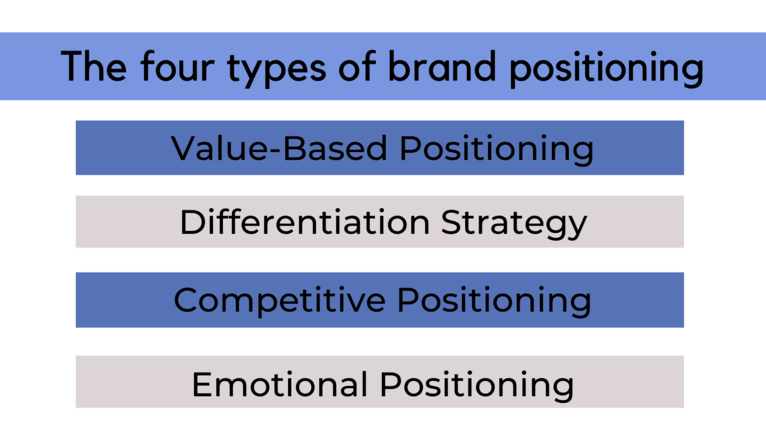Brand Positioning
Brand positioning refers to the process of establishing a distinct and desirable position for a brand in the minds of its target audience. It involves crafting a unique identity and value that differentiates the brand from competitors and resonates with consumers. Effective brand positioning helps shape consumer perceptions, influences purchase decisions, and builds brand loyalty.
Brand positioning - key aspects
Successful brand positioning helps establish a strong brand identity, build consumer trust, and create a competitive advantage in the market. It enables brands to differentiate themselves, connect with their target audience, and ultimately drive business growth.
Here are some key aspects of brand positioning:
- Target Audience
Understanding the target audience is crucial for effective brand positioning. Brands must identify their ideal customers, needs, preferences, and aspirations. By understanding the target audience, brands can tailor their positioning strategy to align with their desires and values.
- Unique Value Proposition
A strong brand positioning requires a clear and compelling unique value proposition (UVP). The UVP highlights what sets the brand apart from competitors and emphasizes the value it delivers to consumers. It communicates the brand's benefits, advantages, and key differentiators.

- Competitive Analysis
Analyzing competitors is essential to identify gaps in the market and carve out a distinctive brand positioning. By understanding the strengths and weaknesses of competitors, brands can position themselves in a way that stands out and offers a unique value proposition to consumers.
- Brand Personality and Messaging
Brand positioning involves shaping the brand's personality and crafting a consistent messaging strategy. The brand personality should resonate with the target audience and reflect the brand's values, tone of voice, and overall identity. The messaging should communicate the brand's positioning, benefits, and values effectively.
- Emotional Connection
Building an emotional connection with consumers is a crucial aspect of brand positioning. Brands that can evoke positive emotions and create meaningful experiences have a higher chance of connecting with their target audience on a deeper level. Emotional branding helps in building brand loyalty and advocacy.
- Consistency and Alignment
Consistency is vital in brand positioning. All brand touchpoints should align with the desired brand positioning, including visuals, messaging, customer interactions, and marketing communications. Consistency reinforces the brand's identity and helps create a coherent and memorable brand experience.
- Monitoring and Adaptation
Brand positioning is an ongoing process. Brands should continuously monitor consumer perceptions, market trends, and competitors' strategies to assess the effectiveness of their positioning. Adjustments and adaptations may be needed to stay relevant and maintain a competitive edge.
What are the four types of brand positioning?
Brand positioning is crucial in brand consulting, marketing planning, and overall business strategy. It helps brands effectively communicate their unique value, differentiate themselves from competitors, and create a strong presence in the market. By strategically positioning their brands, businesses can influence customer perception, shape brand associations, and ultimately drive customer preference and loyalty.
Here is what you should know about the four types of brand positioning:
- Value-Based Positioning:
Value-based positioning focuses on highlighting the unique value and benefits that a brand offers to its target market. This approach emphasizes the brand's ability to fulfill customer needs and solve their problems more effectively than competitors. It involves creating a brand positioning statement communicating its value proposition and differentiation from other brands. Brand managers often use market research and customer insights to identify the specific value drivers that resonate with their target customers.
- Differentiation Strategy
Differentiation positioning distinguishes a brand from its competitors by highlighting its unique qualities or attributes. It involves identifying and leveraging aspects of the brand to make it stand out in the market. This could include product features, brand personality, design, customer experience, or technology. The brand positioning strategy focuses on communicating these distinctive elements to the target market to create a strong brand identity and foster customer loyalty.
- Competitive Positioning
Competitive positioning involves positioning a brand in relation to its competitors. It aims to demonstrate superiority or advantage over other brands within the same market segment. This type of positioning requires a thorough understanding of the competitive landscape and a strategic approach to differentiate the brand from its rivals. Brand managers use market analysis, competitor research, and a deep understanding of customer preferences to develop a brand positioning statement highlighting the brand's unique selling propositions (USPs) and reasons to believe in its superiority.
- Emotional Positioning
Emotional positioning focuses on creating a deep connection between the brand and its target customers. It aims to appeal to customers' emotions, values, and aspirations rather than solely relying on functional benefits. This type of positioning often involves developing a brand voice, personality, and messaging that evoke specific emotions and resonate with the target audience on a deeper level. Emotional positioning seeks to establish a powerful brand associated with specific emotional experiences, building customer loyalty and long-term relationships.